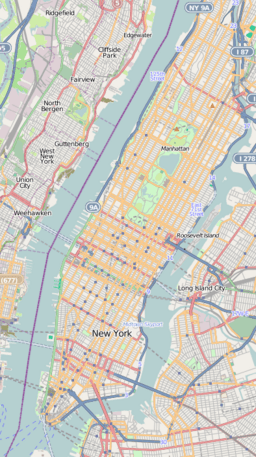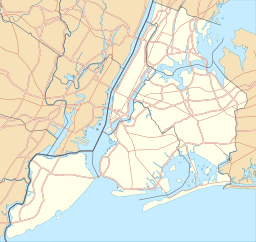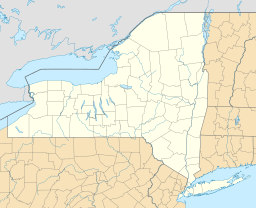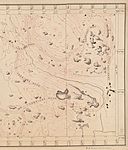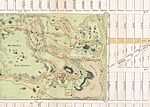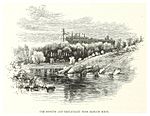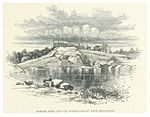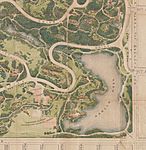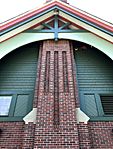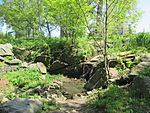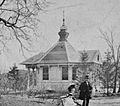Harlem Meer facts for kids
Quick facts for kids Harlem Meer |
|
|---|---|
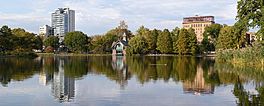
The Harlem Meer and Dana Discovery Center (far shore)
|
|
| Location | Central Park, Manhattan, New York City, New York, USA |
| Coordinates | 40°47′47.8″N 73°57′6″W / 40.796611°N 73.95167°W |
| Type | lake |
The Harlem Meer is a beautiful lake located in the northeast part of Central Park in New York City. It's near the Harlem and East Harlem neighborhoods of Manhattan. The lake has a curvy shoreline that goes around a small hill. This hill once had old gun positions from the War of 1812, but they were never used.
After a skating rink and swimming pool called Lasker Rink were built in 1966, the Harlem Meer became smaller. It is now about 11 acres (45,000 m²) in size. Its edge measures about 0.75 miles (1.2 km) around.
Contents
History of Harlem Meer
The Harlem Meer is a special part of Central Park. It has a rich history of how it was created and changed over time.
How Harlem Meer Was Made
The name "Harlem Meer" comes from the nearby neighborhood of Harlem. "Meer" is a Dutch word that means "lake". This lake is in the northeast corner of Central Park. This area, along with the North Woods and North Meadow, was added to the park later on.
The Meer was dug out in the lowest part of the park. Before it was a lake, it was a swampy area called Harlem Creek. This swamp slowly drained into the East River. The swamp used to separate Harlem from the rest of Manhattan. To avoid the swamp, an old road called the Boston Post Road had to go around it.
The famous designers of Central Park, Frederick Law Olmsted and Calvert Vaux, planned the Meer. The actual work to create the lake and the woods around it began in 1861. This work was led by Andrew Haswell Green.
Changes Over Time
Over the years, the Harlem Meer has been changed several times.
Early Modifications
In the 1940s, the lake's edge and bottom were covered with concrete. This made it hard for plants and animals to live there. In 1962, the city decided to build the Lasker Rink. This rink was built over a part of the Loch, which is near the Harlem Meer.
Building the Lasker Rink made the Meer even smaller. It went from about 10.6 acres to 8.1 acres. The lake was even drained for a short time during this project. When the rink was finished in 1966, it became an ice rink in winter. In summer, it was Central Park's only swimming pool. Later, in 1973, the boathouse at the Meer was fixed up to become a restaurant.
Restoration Efforts
From 1988 to 1993, the Central Park Conservancy worked to restore the Harlem Meer. They removed the concrete edges and replaced them with a more natural shoreline. They also cleaned out the lake, removing a lot of dirt and trash.
As part of this restoration, the Charles A. Dana Discovery Center was built on the north shore. This building is a visitor center for the north end of Central Park. It was designed to look like the old Victorian buildings in the park.
Future Plans
In 2018, plans were announced for a big renovation of the Lasker Rink. This project is expected to close the rink from late 2021 to 2024. The plan is to make the area around the Loch and Harlem Meer more natural again. A new boardwalk will be added along the Loch. A new rink and pool will also be built nearby.
Fun Things to Do at Harlem Meer
The Harlem Meer is a great place for many activities.
Events and Fishing
Next to the Dana Discovery Center, there is a plaza where the Harlem Meer Performance Festival takes place. This festival happens on Sunday afternoons from mid-June to early September.
Fishing is also very popular along the Meer's banks in summer. People practice "catch-and-release" fishing here. This means they catch fish and then let them go. You can find fish like yellow perch and crappie. Sometimes, people even catch a type of fish called a northern snakehead. This fish is known for being an invasive species, which means it's not native to the area and can harm other fish.
Wildlife at the Meer
There is an island in the Meer that is a safe place for water birds. You might see black-crowned night herons there. The Meer also has a group of muskrats living in it.
In Literature
The Harlem Meer has been featured in books. For example, Albert Finch Bellows's book A Description of the New York Central Park (1869) has early pictures of the Meer. Also, Ron P. Swegman's book Small Fry: The Lure of the Little talks about his experiences fly-fishing at the Meer.
Gallery
Images for kids


